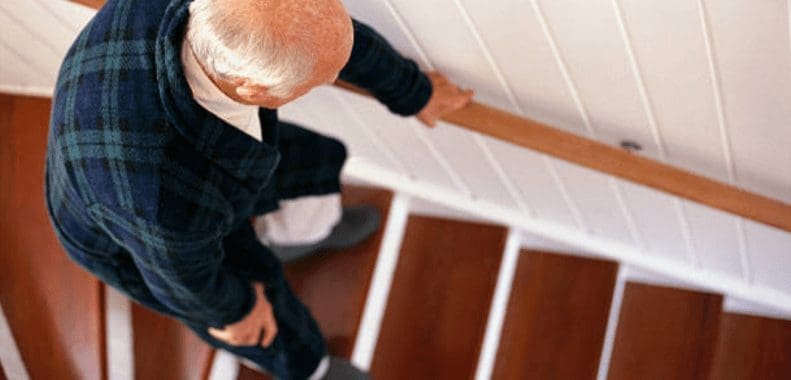JULY 17th, 2018-Falls are a major issue for senior living community residents and staff, especially when dated fall prevention technology is no longer effective. More than one in four people, seniors aged 65 or older fall at least once a year in the United States. The injuries sustained from a fall can be devastating, such as a hip fracture, and in the worst cases a fall injury can result in mortality. Even if a fall does not result in physical injury, it can lead to diminishing confidence and decreased mobility. A fall related injury can profoundly affect quality of life and independence for a senior living resident.
Falls are dangerous to the health of residents, but they can also lead to high medical costs for the community. With these factors in mind, it is no surprise that injury prevention and minimizing the severity of falls remains a top priority in senior living communities.
Many senior living communities employ a plethora of intervention programs, devices, and technological solutions all tasked with preventing falls. Yet many of these are no longer the most effective in preventing falls and maintaining resident safety. Let’s take a look at how these old-school solutions fall short, and why senior living communities should start investing in new fall prevention intervention technology.
The Old School Fall Prevention Technology
The most widely used fall prevention strategy in senior living communities today is to combine nursing interventions with older alert devices to identify residents who need assistance, or potential emergencies. For many communities, these devices may include audible alarm systems, personal emergency response systems, and pull cords.
Audible Alarm Systems
Audible alarm systems immediately alert caregivers when residents get out of bed or chairs. These systems encourage intervention, but audible alarms can be confusing and agitating for residents and do not reduce the number of nightly rounds done by care staff. Additionally, these solutions are primarily reactive and do little to prevent falls. Due to these downsides, many facilities are becoming alarm-free and are implementing technology with data insights for more effective and accurate fall prevention.
PERS
Personal emergency response systems (PERS) are light-weight wearable pendants or bracelets that allow older adults to call for help by pushing a button when they experience a fall or emergency. This technology provides easier access to assistance if older adults are alone. However, these devices are not always worn by residents, especially at night. And if a resident suffers from a fall while wearing the device, they may be unconscious or forget to use it.
Pull Cords
A nurse call system with a pull-cord option can be helpful when residents may not want to wear a PERS (for example when sleeping or showering). The pull cord system allows a resident to pull the device and trigger help from nurses on-staff. However, one of the biggest issues with pull-cord systems is inherent in their design— in order for a resident to activate the pull cord, he or she must be within reach of the system. Falls can happen anywhere, so a location-based system has limited coverage.
The New School Fall Prevention Technology
The technologies listed above are no longer the most effective tools for fall reductions. New technology on the market is working to eliminate some of the shortcomings of these products in order to provide more predictive and preventive fall management methods.
Automatic Wearables Sensor
PERS and global positioning system (GPS) devices have evolved so that they can notify care staff automatically in an emergency. These wearables can be used to gather and track activity data and they are typically worn as a watch or clip-on device. These devices use detection sensors to differentiate between activities of daily living and falls or emergency situations, so the need for help is automatically indicated. They gather data and track changes in baseline behavior to alert the wearer and caregivers about potential health issues. Often they are programmed with the ability to send reminders about activities of daily living and are effective tools to help manage overall physical health. However, similar to PERS devices, residents have to remember and want to wear the devices for them to be effective.
Smart Environment
There are also non-wearable devices which can integrate with a user’s environment. They gather data and provide insights on activities of daily living through a variety of tracking devices in the building (many systems track this differently, but gather similar data). These systems gather both baseline activity data and some can learn the routines of the user. Smart systems can alert caregivers of risk factors when there are significant changes in activity, such as a resident who is out of bed too long at night or not using the toilet for an extended period of time. This data can be used to determine underlying or immediate health issues. These systems must tread a fine line between gathering enough data to be useful and avoiding big-brother stigmas. More complicated systems can also become expensive quickly, as more sensors add material and upkeep costs.
Making A Change
In an ever-changing senior living environment, older fall protection solutions are no longer cutting it. There are better ways to provide health and happiness to senior living residents. New technologies offering automatic alerts, seamless integration, and data insights are worth the investment into just make sure the new technology you want to integrate meets your community’s safety, privacy, and financial goals. Reducing the fall rate in senior living is no small task, and newer technology in combination with fall prevention programs should be utilized to promote the highest quality resident care.



